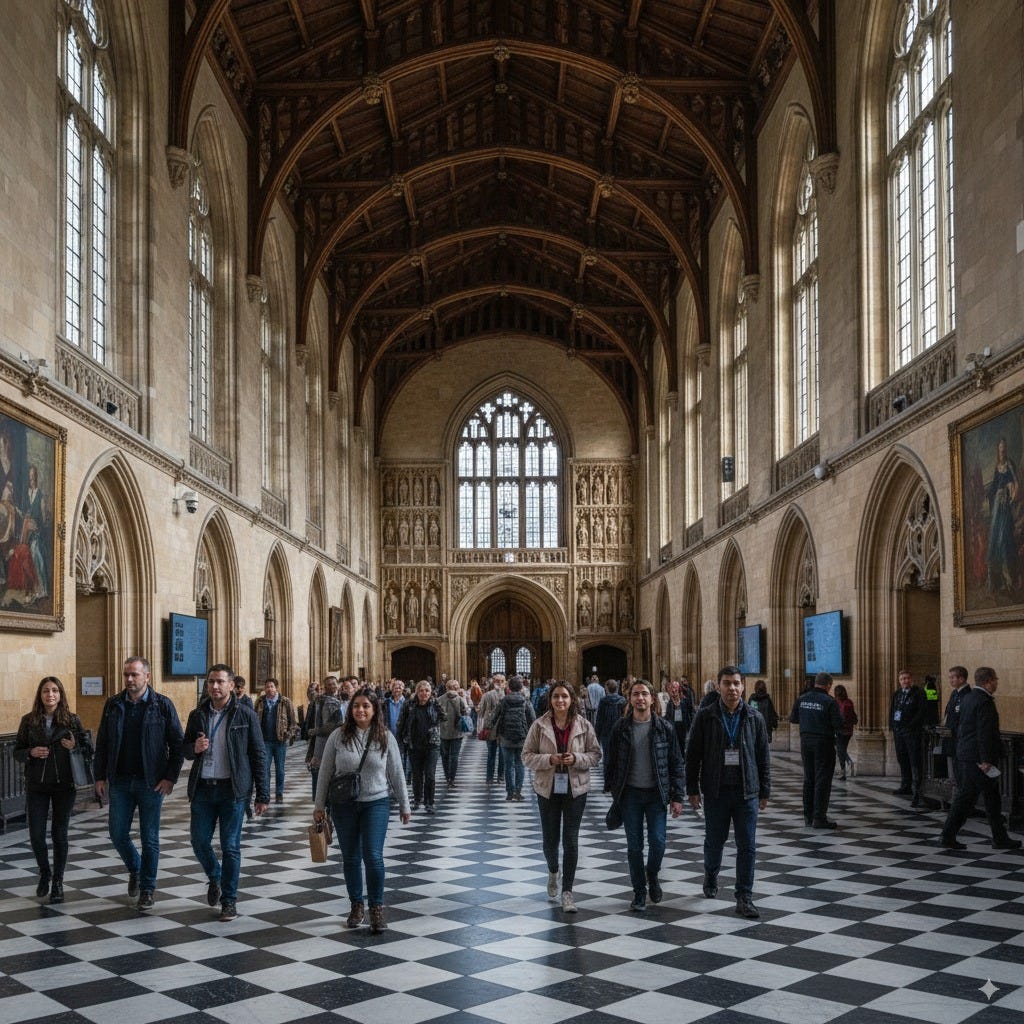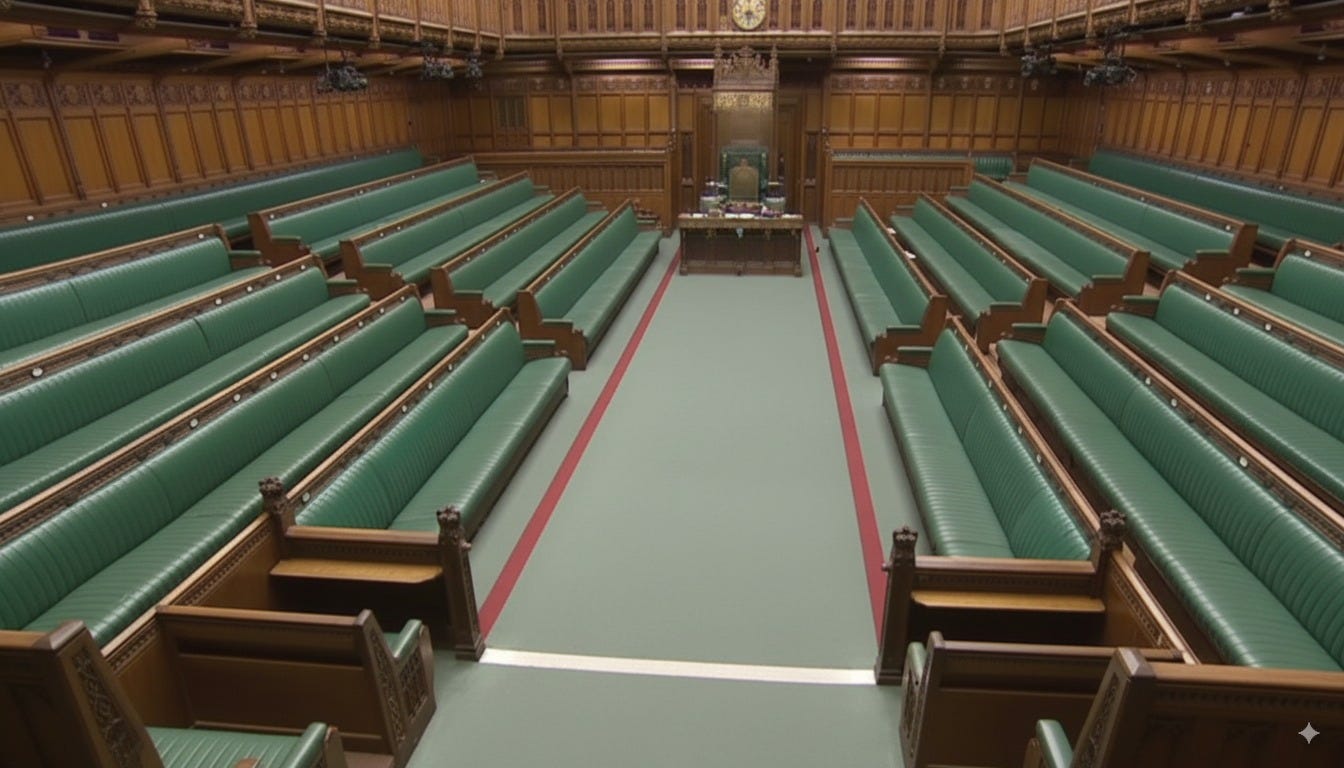This summer I travelled to the UK to visit my family — we’re all British — and while I was there, my dad and I took the Parliament tour, which we both thought was excellent. Here’s a taste of what we experienced.
The Parliament building as we know it today dates back to the Victorian era. In 1834, a great fire destroyed most of the medieval palace, and the entire structure had to be rebuilt. The new design was chosen through a competition, and Prince Albert took a keen interest in the details of the project, guiding its Gothic Revival style.
The tour begins in Westminster Hall, one of the few parts of the original palace that survived the fire. Parts of it date as far back as 1097, making it nearly a thousand years old. The vast hammer-beam roof, added in the 1390s under Richard II, is considered one of the finest in Europe. Westminster Hall has witnessed coronation banquets, the trials of famous figures such as Sir Thomas More and King Charles I, and, in more recent times, historic speeches by world leaders including Barack Obama and Volodymyr Zelensky.
The hall was built beside Westminster Abbey, the coronation church of English monarchs. In medieval times, the abbey was run by Benedictine monks, and the king chose to build his hall nearby so that crown and church could stand side by side.
From the hall, we climbed the steps where visiting leaders address Parliament. It was humbling to stand where so many pivotal speeches in history have been made.
We then moved into the Queen’s (now King’s) Robing Room, where the monarch prepares for the State Opening of Parliament, putting on ceremonial robes and the Imperial State Crown. Walking through, our guide explained how the ceremony is steeped in tradition — even today, Black Rod must knock three times on the Commons’ door before being allowed to summon MPs to the Lords.
From there, we entered the House of Lords. The chamber glitters with red and gold, with the magnificent royal throne at its heart. Standing among the red benches, we could appreciate how the chamber symbolizes continuity and monarchy.
As my dad and I had only ever seen Parliament on TV, we thought we understood the chambers quite well. However, we were surprised to discover that we were mistaken in one very important area: the scale and size. On television, the Lords appears vast, but in person the chamber felt much shorter and more cramped than we expected. Even the narrow gap between the throne and the benches seemed tighter, which made the throne itself look enormous in proportion to the room. Another surprise was how bright and dazzling the gold of the throne appeared in real life — far more striking than it looks on screen.
We then passed through the central corridor, lined with mosaics and statues, and entered the House of Commons. In contrast to the Lords, the Commons chamber is simpler, with green benches instead of red. Our guide explained that it was rebuilt after being destroyed in the Blitz in 1941, and Winston Churchill himself insisted it be reconstructed to the original cramped design, so debate would remain lively.
Once again, though, the size caught us off guard. On TV the Commons always looks long and spacious, but in reality the room is much shorter. The pathways are narrower, the central table is smaller, and the whole chamber feels more intimate than we expected. It was a total shock to us — a reminder that cameras can make spaces look grander than they truly are.
Another fact that surprised me — and sent my mind travelling around the world — was this: most, if not all, of the countries that exist today have been mentioned in these two chambers we. For a time, Parliament was the very centre of the world through the British Empire.
One thing I had never considered before was that every war fought by the Empire was founded in the British government. That meant each decision to go to war was formally debated in Parliament and agreed within these chambers. The thought that such global conflicts began with votes in these very rooms left me stunned.
Even more remarkable was the role of the House of Lords as the final court of appeal for the Empire. It was not the court of appeal for the UK itself, but for Commonwealth nations. This meant that anyone in the Empire who had exhausted their own country’s legal system could appeal directly to the Lords. If you had the means, you could physically travel to London and present your case in person. But if that was too costly — or impossible due to distance — you could simply write a letter. That letter would then be read aloud in the chamber, debated by the Lords, and a ruling made.
Once the decision was reached, the Lords would send a letter back to the individual’s country, as well as to all other Commonwealth nations, explaining the ruling. The decision took effect immediately across the Empire. The sheer reach of this system amazed me — and though the role of the Lords has changed over time, this aspect of legal history has never been entirely erased from its legacy.
Finally, we returned to Westminster Hall, stepping back through nearly a millennium of history before exiting.
Reflection
Walking through Parliament was more than just a tour — it was like stepping inside the living heart of British democracy. One thing that struck me dumb was a fact our guide shared: that while Parliament is steeped in ceremony and tradition, its true essence is debate. For centuries, people have stood in these very chambers, arguing fiercely, disagreeing openly, yet always within the same walls. That balance of continuity and change, of old customs supporting new ideas, suddenly felt very real.
It also made me realise that the grandeur of Parliament is not just in its gold, stone, or wood, but in the voices that have filled it for generations — voices that continue to shape the country today. The scale of the rooms may have been smaller than we imagined, but the weight of history and the importance of the place felt far greater. It is a visit I will never forget — and one that left me proud of our shared history.





